Photo Reportage
Franz Kafka’s Prague
Exploring Prague in Kafka’s footsteps: where did Franz Kafka live and work, where did he spend his leisure time? A photo tour.
By Petr Machan (Photos) and Tomáš Moravec (Text)
Yes, it would be a mistake to limit the scope of Franz Kafka’s activities only to the hundred-spired Czech capital. After all, what about Siřem, where he loved to go to visit his sister’s country estate? What about the Moravian village of Třešt', where he used to spend his holidays? What about Weimar, Paris, Lugano and Brescia, all places he visited alone or with his friend Max Brod? And what about Berlin, Vienna or the infamous Kierling?
Just as we can never retell the full story of a particular person, we cannot record all his traces. So let’s limit ourselves to good old Prague. As Kafka wrote about his hometown: this dear little mother has sharp claws. It should be added that even a hundred years later, these “claws”, which catch you and never let you go, whether you are a native of Prague, an immigrant or a tourist, are still as strong and full of stories.
Houses, apartments, cafés, cinemas, offices and, here and there, an establishment of poor reputation: like every man, Franz Kafka lived, worked and loved. Let’s take a look at where. We invite you to take a historical and architectural walk through Old Prague.
Dům U Věže (The Tower House)
Náměstí Franze Kafky 3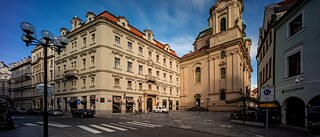
Kafka was born in the Baroque Tower House (named for the tower of the adjacent St. Nicolas Church) on 3 July 1883. On the eighth day after his birth, he was also circumcised there, according to Jewish custom. He only took his very first baby steps there, though. As early as 1885, when little Franz was just two years old, the family moved. The reason for this was the redevelopment of the adjacent Josefov, the Jewish ghetto, to which the Baroque house Tower House fell victim. A few years later, however, a replica was built. It stands a few metres further back and is slightly taller than the original house, but the original Baroque portal and balcony have been incorporated into the new building. So yes and no: Kafka was not born in this corner house, but he entered the world through the Baroque portal you see in the photo.
Dům U Minuty (The House at the Minute)
Staroměstské náměstí 2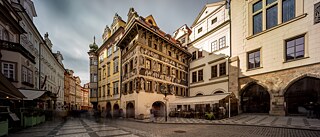
All three of Kafka’s sisters were born in short succession in the house, whose name comes from the Italian “al minuto” (small goods were sold there): Gabrielle (Elli), Valerie (Valli) and Ottilie (Ottla). And it was also probably the local long balcony that the little naughty Kafka had been pushed out onto one night, an experience he wrote about many years later in his famous and never-sent Letter to His Father.
Then, there is one more memory: this is the place from which, in September 1889, Franz Kafka went to school from for the first time. Again, the school was not far away, but the way there was becoming thorny: it was still okay for him to cross the vast square, but in the winding Gothic lanes around the Týn Cathedral, little Franz would pull the cook back by her skirt and hold on to houses by their guard stones, as he was afraid to go to school, although he had no reason to be. After all, read his letters to Milena, in which he described those difficult journeys to school very beautifully.
Dům U Tří králů (The House of the Three Kings)
Celetná 3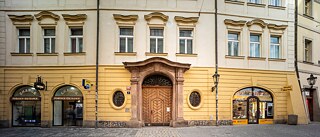
Throughout his studies at grammar school and university, Kafka lived here. The Czech governess of his sisters recalled that “the young master was tall, slender, of a serious disposition, not very talkative ... the door of his room was always open. Next to the door was a writing desk, on it sat two volumes of Roman law.” Reiner Stach also recalls the history of Roman law, a two-volume, 2,500 page tome, in the chapter Enticements of the first volume of his Kafka trilogy entitled Kafka: The Early Years. It is this book of Roman law that is said to have caused Kafka to learn something more than just legal phrases. From his textbook, which was placed on a table by an open window, he is said to have, way too often, looked down onto Celetná Street, where there was a clothing shop and a charming shopkeeper. The latter, for a change, began to peep up into the window of the dashing student. The rest is history with some gossip, but only one thing is certain: the lovely shopkeeper did not make the list of Kafka’s fateful foursome of women.
Palác Hrzánů z Harasova (The Hrzán Palace)
Celetná 12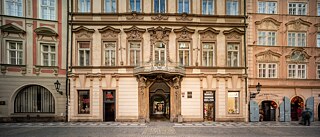
By that time Kafka had already written, for example, Description of a Struggle (1904/1905) and was working on the short story Wedding Preparations in the Country (1907/1908). 12 Celetna Street was also his home address when he was writing (and publishing!), for instance, Conversation with the Drunk (1909), or when he was creating his enthusiastic report The Aeroplanes at Brescia (1909), about the planes he had admired on his Italian trip with Max Brod.
Palác Gotz-Kinských (The Gotz-Kinský Palace)
Staroměstské náměstí 3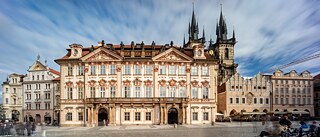
The Old Town (then still called The Great) Square was the centre of Prague, a famous city, and to live – or work – there, at the best address, was a demonstration of success and social stability. For Kafka’s mother, Julia née Löwy, this was nothing new – her family had lived on this square for a long time and she herself had grown up there. But for Hermann Kafka, a merchant from a poor family in southern Bohemia, living there or in the immediate vicinity marked social ascendancy – when Kafka’s family moved, it was never more than a few dozen or a few hundred metres.
Dům U Lodi (The House at the Boat)
Pařížská ulice 36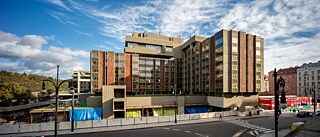
In September 1912, Franz Kafka wrote his short story The Judgment here in one night. And in the same year, he also wrote another piece of literature there: The Metamorphosis. If you read it carefully and compare it with what we know about the Kafkas’ apartment in the House at the Boat, you will find that this is the place where the story is set. The famous apartment with Kafka’s walk-through room, where Gregor Samsa woke up one morning from restless dreams, no longer exists. It is an irony of history that the place where The Metamorphosis was written has itself long since changed beyond recognition.
Oppeltův dům (The Oppelt House)
Staroměstské náměstí 5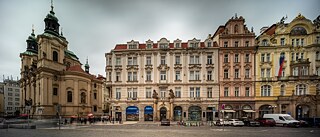
After his illness broke out in 1917, he would, from time to time, return to his parents’ apartment, located only 100 metres from where he had been born. He once showed his Hebrew teacher, Friedrich Thieberger, the view from the window of Oppelt’s house and said: “Here was my grammar school, there in the building opposite was the university, and a little further to the left was my office. This little circle” – and he made a couple of small circles with his fingers – “encompasses my whole life.”
Prague Castle
Zlatá ulička 22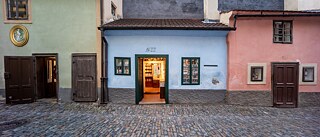
In the summer of 1916, Kafka’s sister Ottla rented House No. 22, but left it to her brother, who came here to write from about November 1916 to March 1917; he was looking for a quiet place, because his bachelor apartment in the House U Zlatého sumce (At the Golden Catfish) in Dlouhá Street did not offer the silence he needed. And what did he write here? In the shadow of St. Wenceslas Cathedral, in the very heart of the Czech capital, he produced a work that was quite unurban: a collection of short stories called A Country Doctor. The model for the doctor, by the way, was his maternal uncle, Siegfried Löwy.
Schönbornský palác (The Schönborn Palace)
Tržiště 15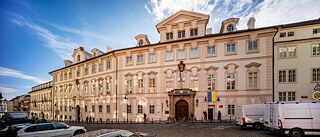
His enthusiasm soon cooled: he eventually got an apartment in the Schönborn Palace, a magnificent Baroque building from the second half of the 17th century, but a different one. It was smaller, a bit cosier, on the second floor and overlooking the street: “I can have the apartment overlooking the street for 600, but without the furniture, on which I had counted. Two rooms and a hall. It has electric light but no bathroom, no tub, but this I don’t really need.” Then, when he put a small borrowed bed in the great room of the Baroque palace, he became anxious, and only stayed there from March to September 1917. Then he went back to his parents’ apartment in Oppelt House and on 2 September 1917 he wrote to Sister Ottla: “Well, I’ve moved out. I closed the windows in the palace for the last time, locked the door, how similar that must be to dying.”
Since 1924, the palace has housed the U.S. Embassy.
Assicurazioni Generali
Václavské náměstí 19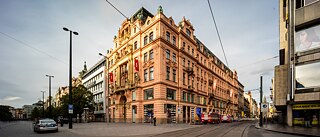
Franz Kafka entered the magnificent neo-Baroque building on Wenceslas Square, which the insurance company had commissioned from Friedrich Ohmann (with Osvald Polívka responsible for later adaptations), (by his own standards) full of optimism. Soon, however, the job began to get to him: he especially complained about the lack of free time and dreamed that his uncle in Madrid could arrange for him another, better and more exciting job: ideally somewhere overseas. However, this never happened, and after nine months Kafka quit his job (allegedly on account of his health) and went on to work, not overseas, but just a few streets away, in the Úrazová pojišťovna dělnická pro Království české (Worker’s Accident Insurance Institute for the Kingdom of Bohemia).
Kino Ponrepo (The Ponrepo Cinema)
Karlova 20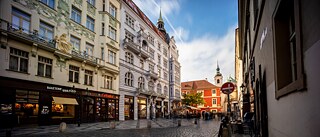
The cinema as such was called Bio Ponrepo and was run by illusionist Viktor Ponrepo (whose actual name was Dismas Šlambor). You won’t find it there anymore, but it still exists just a few streets away. Although Franz Kafka did not live to be able to go to its current address in Bartolomějská Street, he is still present there today: this cinema, run today by the Czech National Film Archive, likes to screen Kafka-related material from time to time, such as Kafka’s favourite films, including The White Slave Girl (Den hvide sklavehandel, 1911). The screening, of course, takes place with the support of the Goethe-Institut.
Cafe Arco (Arco Café)
Dlážďěná 6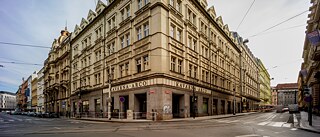
Many German-language authors were linked to Arco Café, including Egon Erwin Kisch, Franz Werfel, Oskar Baum and Max Brod, who would bring along his friend Franz Kafka. The latter was quite fond of spending time at the café, but unlike the other authors mentioned, he was not a regular. However, today he is the first person that Prague residents associate with Arco Café. Kafka has thus managed to overshadow, for example, Albert Einstein, who used to come to Arco Café when he was living in Prague in 1911/1912.
Salon GoGo (The GoGo Salon)
Kamzíkova 6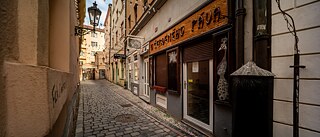
The Gogo Salon, named in honour of its first operator, the junk dealer Abraham “Gogo” Goldschmied, was centrally located (Hermann Kafka’s shop on Old Town Square is only a three-minute walk away), but – as befits an establishment of this reputation – conveniently tucked away in the winding and inconspicuous Kamzíkova Street. Inspired by the name of the street (the Czech word “kamzík” translates as “chamois”), by the way, guests would allegedly refer to visits to the ladies at the brothel as “chamois hunting”. How many such chamois Franz Kafka visited at the Red Peacock House is unclear. However, he told us himself that he quite enjoyed the night-life in establishments such as GoGo, Trocadero and Eldorado. “Ich ging an dem Bordell vorüber wie an dem Haus einer Geliebten,” (I passed by the brothel as though past the house of a beloved) he wrote in his diary 1 January 1910.
Dělnická úrazová pojišťovna (The Worker’s Accident Insurance Institute)
Na Poříčí 7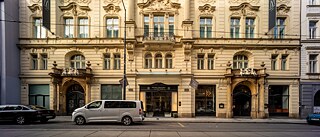
After he left Assicurazioni Generali, Kafka’s workplace for the next (and last) 14 years of his life was the neo-Baroque building of the Worker’s Accident Insurance Institute for the Kingdom of Bohemia. It was the largest financial institution in the Austro-Hungarian Empire, dealing with accident insurance. Kafka had about 260 colleagues, Czechs and Germans. Only three Jews worked at institute when he joined it. While Kafka rose in the hierarchy over the years, his office would gradually be moved onto lower floors: at first he sat on the fourth floor, but after his appointment as deputy secretary, his office was on the first floor, next to the director’s office. Incidentally, the building is now a hotel, which is very much aware of its Kafkaesque past.
Nový židovský hřbitov (The New Jewish Cemetery)
Izraelská 1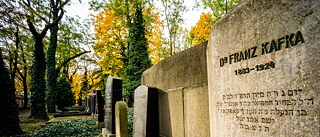
Pomník Franze Kafky (The Statue of Franz Kafka)
Dušní ulice 1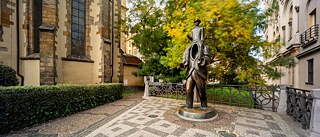
At least one of these commemorative objects is worth a closer look: the bronze Statue of Franz Kafka, which has stood near the Spanish Synagogue since 2003. It was created for the Franz Kafka Society by the famous Czech sculptor Jaroslav Róna, who was inspired by a quote from The Description of a Struggle: “In an instant and with unusual deftness I had jumped on the shoulders of my acquaintance and by stabbing my fists into his back brought him to a light canter.”